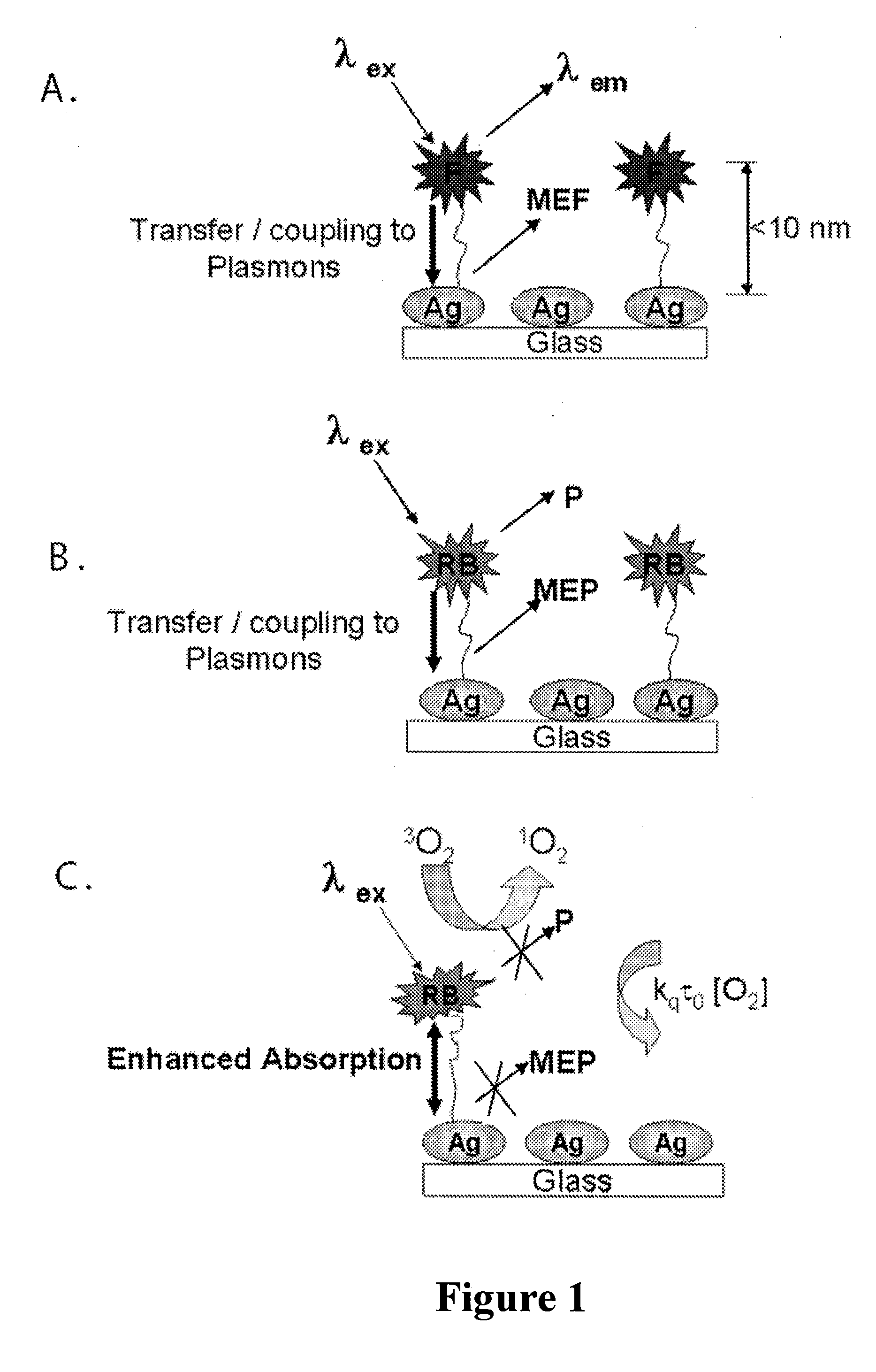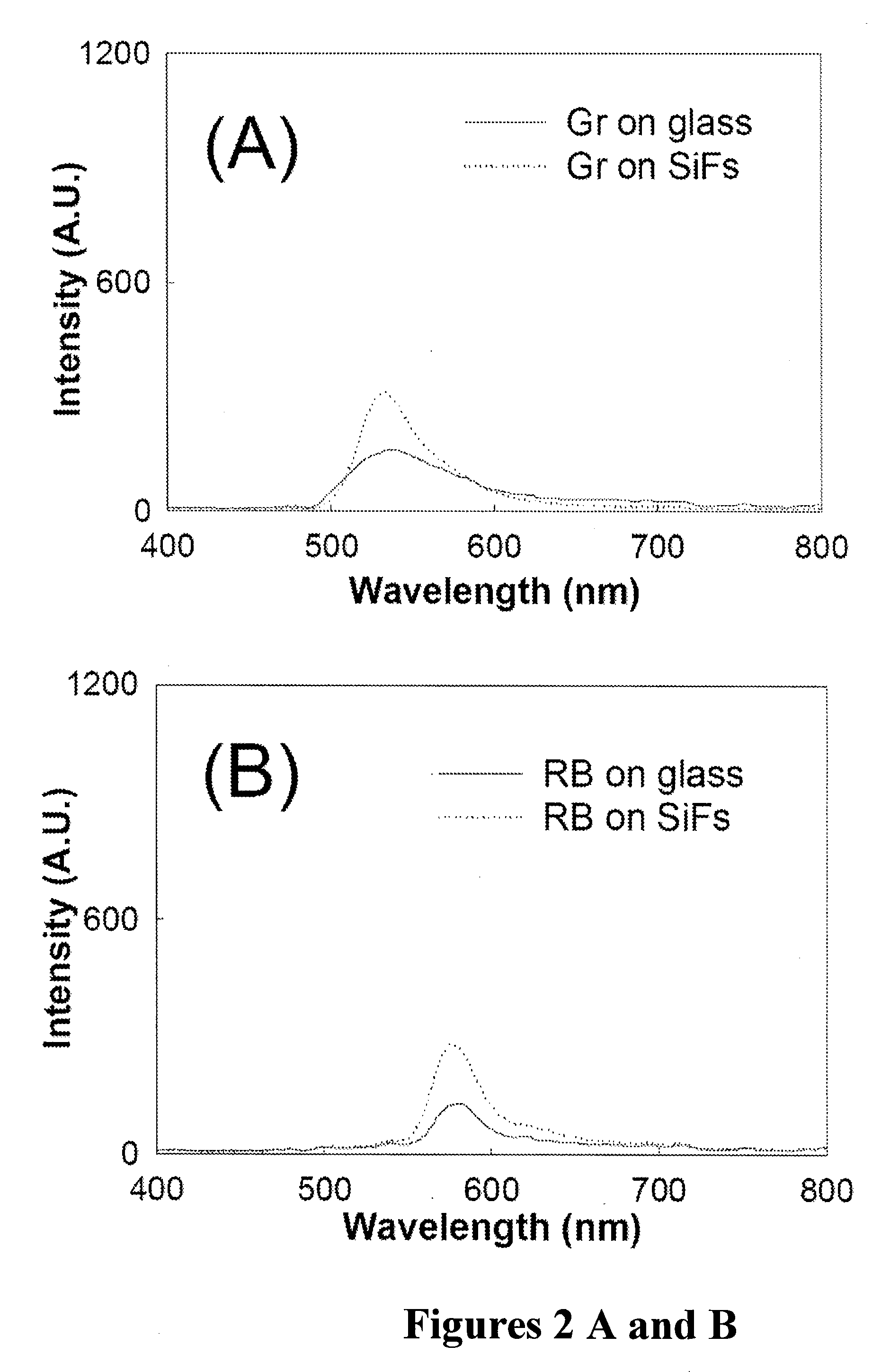Plasmonic engineering of singlet oxygen and/or superoxide generation
a technology of singlet oxygen and superoxide, applied in the field of singlet oxygen generation, can solve the problems of oxygen depletion and photosensitizer photo-bleaching, cell death and tumor destruction, and limitations of this method, and achieve the effect of increasing the triplet yield of photosensitizers and increasing the singlet oxygen generation
- Summary
- Abstract
- Description
- Claims
- Application Information
AI Technical Summary
Benefits of technology
Problems solved by technology
Method used
Image
Examples
example 1
[0094]Determining Properties of ME 1O2.
[0095]FDTD methods were used to demonstrate direct evidence for the relationship of electric field enhancements around nanoparticles and the increase in triplet yields for a photosensitizer and the subsequent increase in singlet oxygen generation. Several photosensitizers were studied wherein each photosensitizer had singlet oxygen yields ranging from 0.08 to 1.00 and were sandwiched between silver island films (SiFs) for Metal-Enhanced singlet oxygen generation (ME1O2). Notably, an inverse relationship between singlet oxygen enhancement factor and the free-space singlet oxygen quantum yield was observed. In addition, it was observed that there was a distance dependence for the generation of ME1O2 from photosensitizers on SiFs substrates using SiOx layers 0.5, 2, 5, 10 nm thick. These observations are consistent with numerous distance dependence measurements for MEF and MEP themselves.
[0096]Since Rose Bengal is a commonly used photosensitizer w...
example 2
[0105]A solution of 500 μl of Rose Bengal (0.1 mM) in ethanol and a solution of 500 μl GR (4.5 mM) also in ethanol was dropped in a sandwich format between the glass slides and the silver island films (SiFs), respectively. FIG. 7-Top shows the experimental sandwich sample geometry. The glass / SiFs surfaces were exposed to UV-light (365 nm (100 W)) for 2 min for singlet oxygen generation, with the green sensor dye fluorescence collected at 45° to the excitation through a long pass filter, using a Fiber Optic Spectrometer (HD2000) from Ocean Optics, Inc.
[0106]FIG. 7-Bottom shows the fluorescence emission spectra of a mixture of GR and Rose Bengal solutions on glass and SiFs, before and after UV light exposure. While the peak at 588 nm is the Rose Bengal fluorescence emission and not related with singlet oxygen (12), the peak at 525 nm originates from the GR sensor dye emission and directly correlates with singlet oxygen yield. It can be seen that the fluorescence emission intensity at ...
example 3
[0111]Superoxide Generation
[0112]SiFs were deposited on glass slides as previously published and described above. DHE, a well known superoxide probe, is highly selective for superoxide and in the presence of superoxide, it emits an orange fluorescence (excitation / emission: 473 nm / 586 nm). A 300 μl solution of the photosensitizer, acridine (50 μM in ethanol) and DHE (0.845 mM in ethanol), was trapped in a sandwich format between the glass and the silver island films, as shown in the FIG. 9, insert. A control sample, which uses the same glass slides but with no silver deposits, was used to determine the extent of the plasmon-enhanced superoxide generation. Glass slides were deemed appropriate due to the long wavelength absorption of the acridine photosensitizer and DHE probe (430 and 473 nm, respectively) as compared to the intrinsic absorption by glass (2 coatings, for distance dependence measurements, were deposited using thermal vapor deposition (Edwards Auto 380), where the SiO2 l...
PUM
 Login to View More
Login to View More Abstract
Description
Claims
Application Information
 Login to View More
Login to View More - R&D
- Intellectual Property
- Life Sciences
- Materials
- Tech Scout
- Unparalleled Data Quality
- Higher Quality Content
- 60% Fewer Hallucinations
Browse by: Latest US Patents, China's latest patents, Technical Efficacy Thesaurus, Application Domain, Technology Topic, Popular Technical Reports.
© 2025 PatSnap. All rights reserved.Legal|Privacy policy|Modern Slavery Act Transparency Statement|Sitemap|About US| Contact US: help@patsnap.com



